Page 172 of 304

172 OperationEngine compartment
Closing�
Let the hood drop from a height of ap-
proximately 1ft (30cm).
The hood will lock audibly.
�
Check to make sure that the hood is
fully closed.
If you can raise the hood at a point
above the headlamps, then it is not
properly closed. Open it again and let it
drop with somewhat greater force.
Engine oil
The amount of oil your engine needs will
depend on a number of factors, including
driving style. Higher oil consumption can
occur when�
the vehicle is new
�
the vehicle is driven frequently at high-
er engine speeds
Engine oil consumption checks should only
be made after the vehicle break-in period.
Checking engine oil level
When checking the oil level the vehicle
must
�
be parked on level ground
�
be at normal operating temperature
�
have been stationary for at least five
minutes with the engine turned off
Warning!
G
If you see flames or smoke coming from the
engine compartment, or if the coolant tem-
perature gauge indicates that the engine is
overheated, do not open the hood. Move
away from vehicle and do not open the hood
until the engine has cooled. If necessary,
call the fire department.Warning!
G
The engine is equipped with a transistorized
ignition system. Because of the high voltage
it is dangerous to touch any components (ig-
nition coils, spark plug sockets, diagnostic
socket) of the ignition system�
with the engine running
�
while starting the engine
�
if ignition is “on” and the engine is
turned manually
Warning!
G
Be careful that you do not close the hood on
anyone.
Page 176 of 304
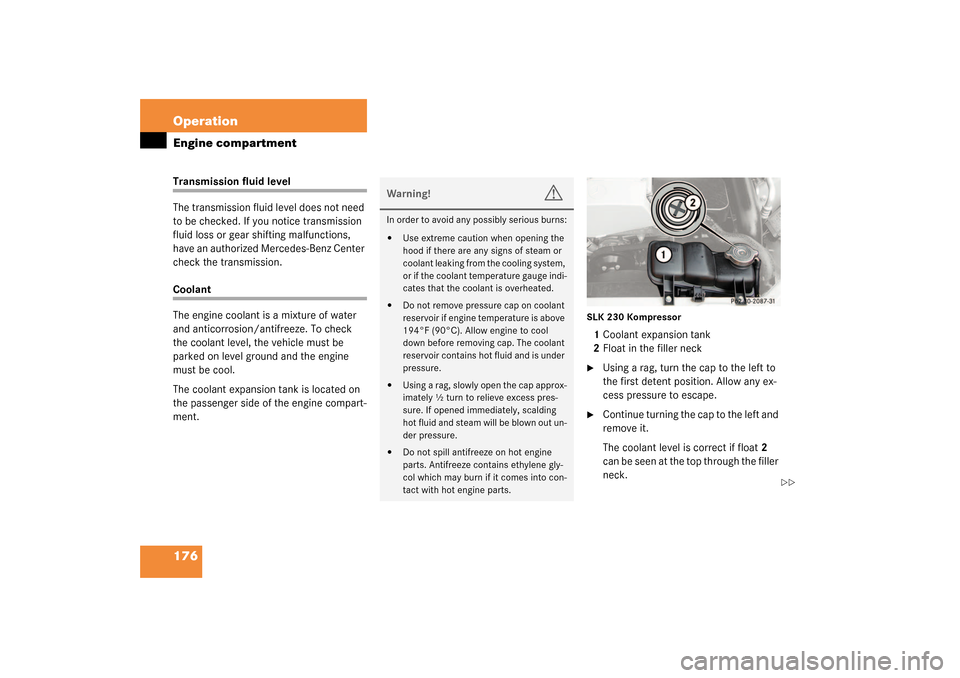
176 OperationEngine compartmentTransmission fluid level
The transmission fluid level does not need
to be checked. If you notice transmission
fluid loss or gear shifting malfunctions,
have an authorized Mercedes-Benz Center
check the transmission.Coolant
The engine coolant is a mixture of water
and anticorrosion/antifreeze. To check
the coolant level, the vehicle must be
parked on level ground and the engine
must be cool.
The coolant expansion tank is located on
the passenger side of the engine compart-
ment.
SLK 230 Kompressor1Coolant expansion tank
2Float in the filler neck�
Using a rag, turn the cap to the left to
the first detent position. Allow any ex-
cess pressure to escape.
�
Continue turning the cap to the left and
remove it.
The coolant level is correct if float2
can be seen at the top through the filler
neck.
Warning!
G
In order to avoid any possibly serious burns:�
Use extreme caution when opening the
hood if there are any signs of steam or
coolant leaking from the cooling system,
or if the coolant temperature gauge indi-
cates that the coolant is overheated.
�
Do not remove pressure cap on coolant
reservoir if engine temperature is above
194°F (90°C). Allow engine to cool
down before removing cap. The coolant
reservoir contains hot fluid and is under
pressure.
�
Using a rag, slowly open the cap approx-
imately ½ turn to relieve excess pres-
sure. If opened immediately, scalding
hot fluid and steam will be blown out un-
der pressure.
�
Do not spill antifreeze on hot engine
parts. Antifreeze contains ethylene gly-
col which may burn if it comes into con-
tact with hot engine parts.
��
Page 177 of 304
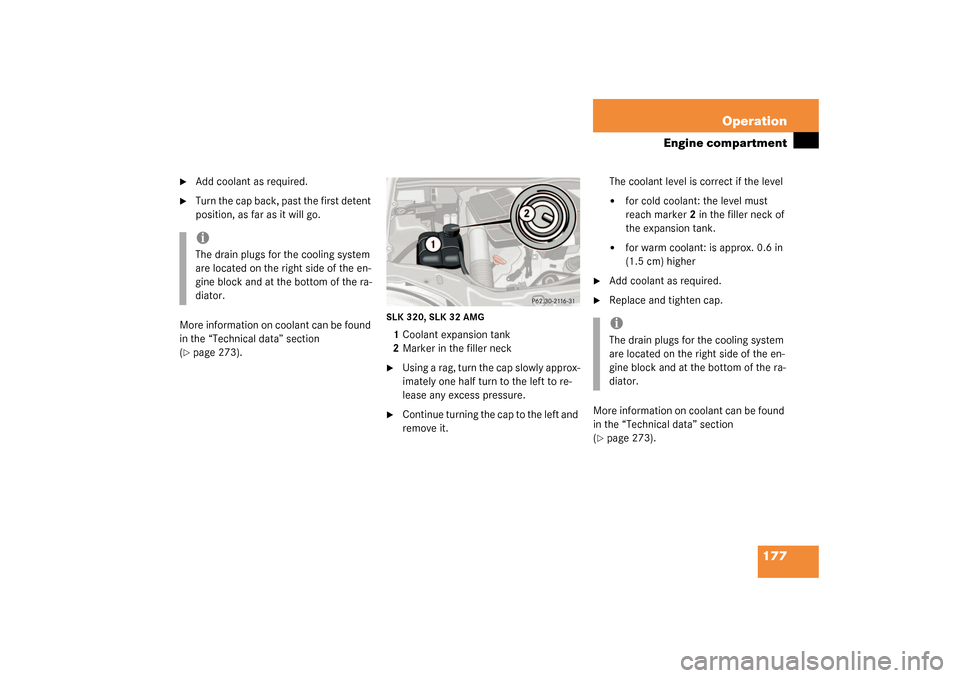
177 Operation
Engine compartment
�
Add coolant as required.
�
Turn the cap back, past the first detent
position, as far as it will go.
More information on coolant can be found
in the “Technical data” section
(
�page 273).
SLK 320, SLK 32 AMG1Coolant expansion tank
2Marker in the filler neck�
Using a rag, turn the cap slowly approx-
imately one half turn to the left to re-
lease any excess pressure.
�
Continue turning the cap to the left and
remove it.The coolant level is correct if the level
�
for cold coolant: the level must
reach marker2 in the filler neck of
the expansion tank.
�
for warm coolant: is approx. 0.6 in
(1.5 cm) higher
�
Add coolant as required.
�
Replace and tighten cap.
More information on coolant can be found
in the “Technical data” section
(
�page 273).
iThe drain plugs for the cooling system
are located on the right side of the en-
gine block and at the bottom of the ra-
diator.
iThe drain plugs for the cooling system
are located on the right side of the en-
gine block and at the bottom of the ra-
diator.
Page 201 of 304
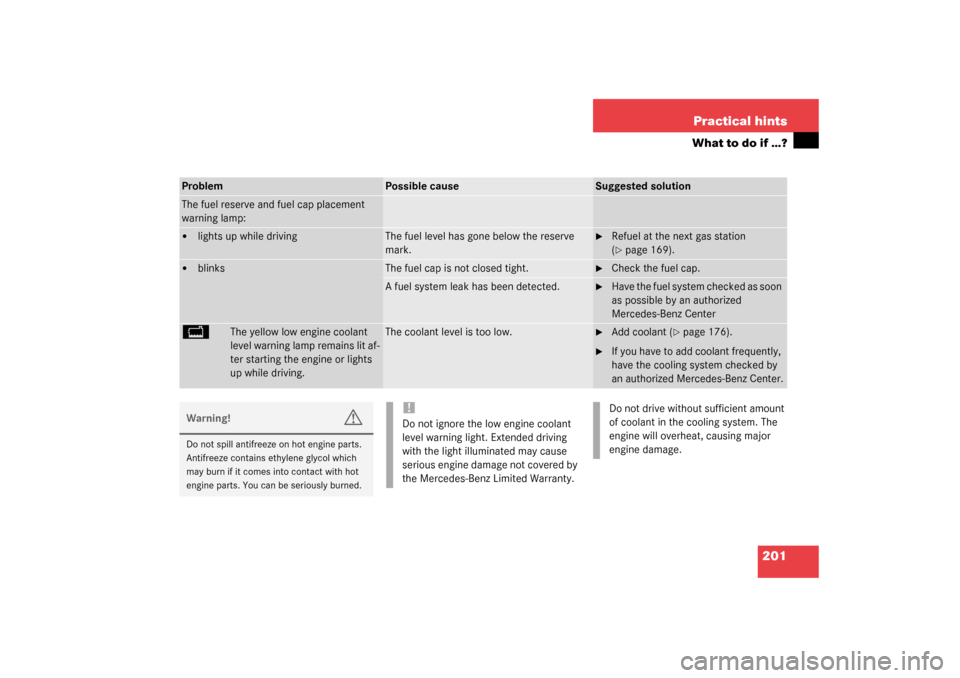
201 Practical hints
What to do if …?
Problem
Possible cause
Suggested solution
The fuel reserve and fuel cap placement
warning lamp:�
lights up while driving
The fuel level has gone below the reserve
mark.
�
Refuel at the next gas station
(�page 169).
�
blinks
The fuel cap is not closed tight.
�
Check the fuel cap.
A fuel system leak has been detected.
�
Have the fuel system checked as soon
as possible by an authorized
Mercedes-Benz Center
B
The yellow low engine coolant
level warning lamp remains lit af-
ter starting the engine or lights
up while driving.
The coolant level is too low.
�
Add coolant (
�page 176).
�
If you have to add coolant frequently,
have the cooling system checked by
an authorized Mercedes-Benz Center.
Warning!
G
Do not spill antifreeze on hot engine parts.
Antifreeze contains ethylene glycol which
may burn if it comes into contact with hot
engine parts. You can be seriously burned.
!Do not ignore the low engine coolant
level warning light. Extended driving
with the light illuminated may cause
serious engine damage not covered by
the Mercedes-Benz Limited Warranty.
Do not drive without sufficient amount
of coolant in the cooling system. The
engine will overheat, causing major
engine damage.
Page 255 of 304
255 Technical data
Spare parts service
Warranty coverage
Identification labels
Layout of poly-V-belt drive
Engine
Rims and Tires
Electrical system
Main Dimensions
Weights
Fuels, coolants, lubricants etc.
Consumer information
Page 269 of 304
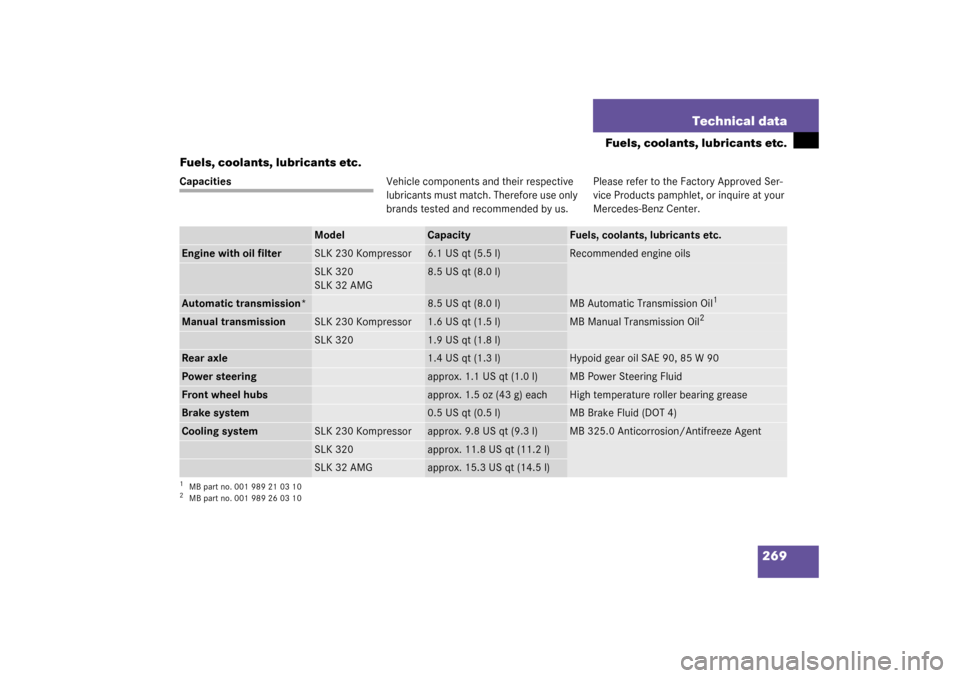
269 Technical data
Fuels, coolants, lubricants etc.
Fuels, coolants, lubricants etc.
CapacitiesVehicle components and their respective
lubricants must match. Therefore use only
brands tested and recommended by us.Please refer to the Factory Approved Ser-
vice Products pamphlet, or inquire at your
Mercedes-Benz Center.
Model
Capacity
Fuels, coolants, lubricants etc.
Engine with oil filter
SLK 230 Kompressor
6.1 US qt (5.5 l)
Recommended engine oils
SLK 320
SLK 32 AMG
8.5 US qt (8.0 l)
Automatic transmission*
8.5 US qt (8.0 l)
MB Automatic Transmission Oil
1
1MB part no. 001 989 21 03 10Manual transmission
SLK 230 Kompressor
1.6 US qt (1.5 l)
MB Manual Transmission Oil
2
2MB part no. 001 989 26 03 10
SLK 320
1.9 US qt (1.8 l)
Rear axle
1.4 US qt (1.3 l)
Hypoid gear oil SAE 90, 85 W 90
Power steering
approx. 1.1 US qt (1.0 l)
MB Power Steering Fluid
Front wheel hubs
approx. 1.5oz (43g) each
High temperature roller bearing grease
Brake system
0.5 US qt (0.5 l)
MB Brake Fluid (DOT 4)
Cooling system
SLK 230 Kompressor
approx. 9.8 US qt (9.3 l)
MB 325.0 Anticorrosion/Antifreeze Agent
SLK 320
approx. 11.8USqt (11.2l)
SLK 32 AMG
approx. 15.3USqt (14.5l)
Page 271 of 304
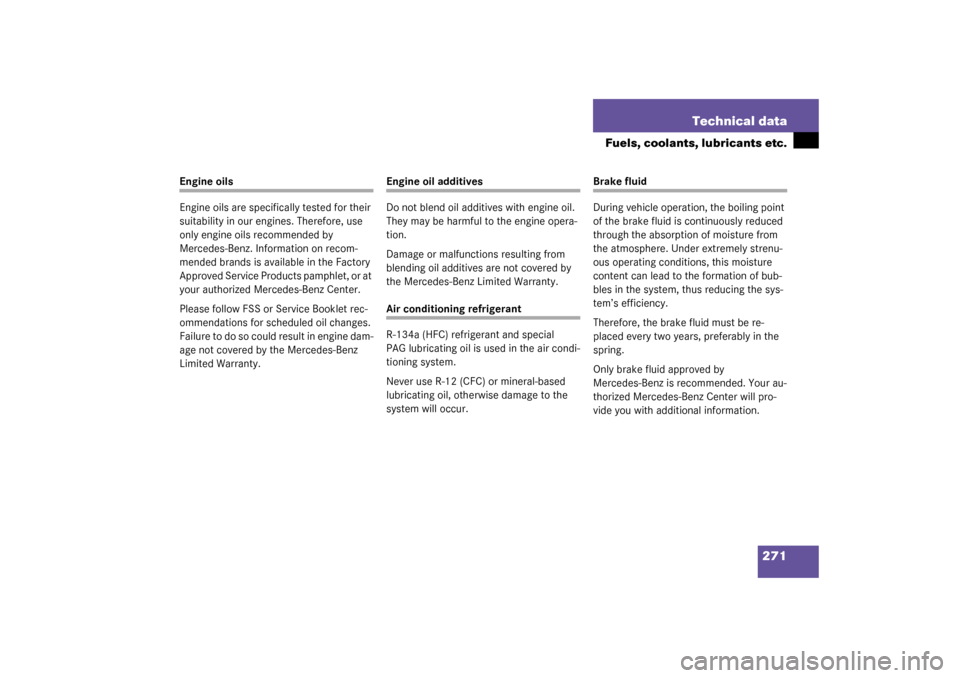
271 Technical data
Fuels, coolants, lubricants etc.
Engine oils
Engine oils are specifically tested for their
suitability in our engines. Therefore, use
only engine oils recommended by
Mercedes-Benz. Information on recom-
mended brands is available in the Factory
Approved Service Products pamphlet, or at
your authorized Mercedes-Benz Center.
Please follow FSS or Service Booklet rec-
ommendations for scheduled oil changes.
F ai lu re to d o s o could res ul t in engi ne da m -
age not covered by the Mercedes-Benz
Limited Warranty.
Engine oil additives
Do not blend oil additives with engine oil.
They may be harmful to the engine opera-
tion.
Damage or malfunctions resulting from
blending oil additives are not covered by
the Mercedes-Benz Limited Warranty.Air conditioning refrigerant
R-134a (HFC) refrigerant and special
PAG lubricating oil is used in the air condi-
tioning system.
Never use R-12 (CFC) or mineral-based
lubricating oil, otherwise damage to the
system will occur.
Brake fluid
During vehicle operation, the boiling point
of the brake fluid is continuously reduced
through the absorption of moisture from
the atmosphere. Under extremely strenu-
ous operating conditions, this moisture
content can lead to the formation of bub-
bles in the system, thus reducing the sys-
tem’s efficiency.
Therefore, the brake fluid must be re-
placed every two years, preferably in the
spring.
Only brake fluid approved by
Mercedes-Benz is recommended. Your au-
thorized Mercedes-Benz Center will pro-
vide you with additional information.
Page 272 of 304
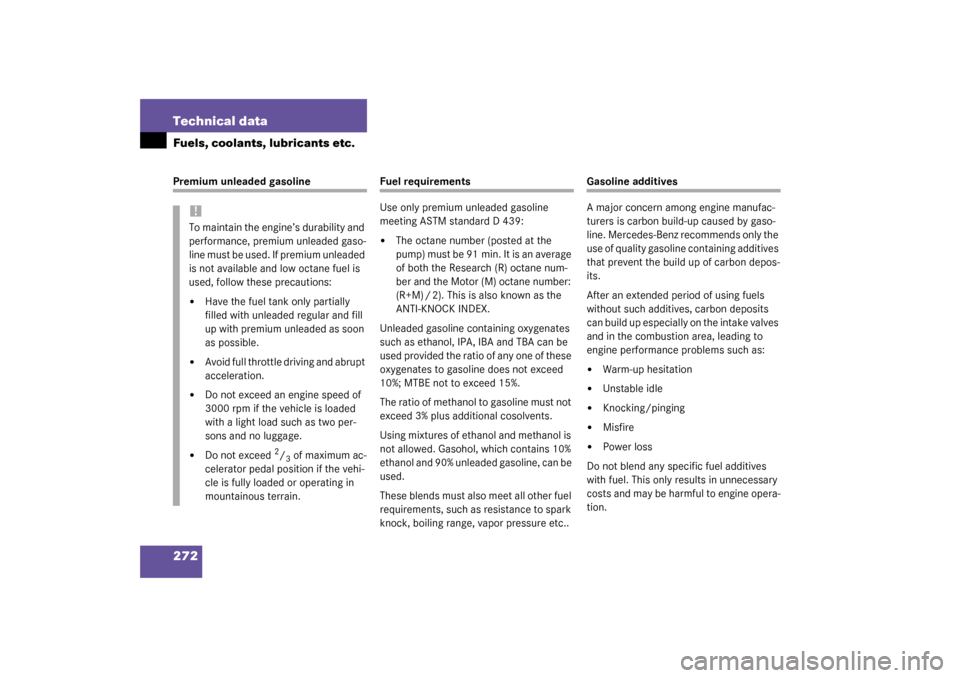
272 Technical dataFuels, coolants, lubricants etc.Premium unleaded gasoline
Fuel requirements
Use only premium unleaded gasoline
meeting ASTM standard D 439:�
The octane number (posted at the
pu mp ) m us t b e 91 mi n. It is an a ve ra ge
of both the Research (R) octane num-
ber and the Motor (M) octane number:
(R+M) / 2). This is also known as the
ANTI-KNOCK INDEX.
Unleaded gasoline containing oxygenates
such as ethanol, IPA, IBA and TBA can be
used provided the ratio of any one of these
oxygenates to gasoline does not exceed
10%; MTBE not to exceed 15%.
The ratio of methanol to gasoline must not
exceed 3% plus additional cosolvents.
Using mixtures of ethanol and methanol is
not allowed. Gasohol, which contains 10%
ethanol and 90% unleaded gasoline, can be
used.
These blends must also meet all other fuel
requirements, such as resistance to spark
knock, boiling range, vapor pressure etc..
Gasoline additives
A major concern among engine manufac-
turers is carbon build-up caused by gaso-
line. Mercedes-Benz recommends only the
use of quality gasoline containing additives
that prevent the build up of carbon depos-
its.
After an extended period of using fuels
without such additives, carbon deposits
can build up especially on the intake valves
and in the combustion area, leading to
engine performance problems such as:�
Warm-up hesitation
�
Unstable idle
�
Knocking/pinging
�
Misfire
�
Power loss
Do not blend any specific fuel additives
with fuel. This only results in unnecessary
costs and may be harmful to engine opera-
tion.
!To maintain the engine’s durability and
performance, premium unleaded gaso-
line must be used. If premium unleaded
is not available and low octane fuel is
used, follow these precautions:�
Have the fuel tank only partially
filled with unleaded regular and fill
up with premium unleaded as soon
as possible.
�
Avoid full throttle driving and abrupt
acceleration.
�
Do not exceed an engine speed of
3000 rpm if the vehicle is loaded
with a light load such as two per-
sons and no luggage.
�
Do not exceed
2/3of maximum ac-
celerator pedal position if the vehi-
cle is fully loaded or operating in
mountainous terrain.